
In today's rapidly evolving digital landscape, businesses face a critical decision when it comes to software development: should they build an in-house team or leverage offshore development resources? This choice can significantly impact a company's bottom line, productivity, and long-term success. As the demand for skilled developers continues to outpace supply in many Western countries, particularly the United States, offshore software development has emerged as a compelling alternative to traditional in-house teams.
This comprehensive guide will delve deep into the true costs associated with both in-house and offshore development teams, providing you with the insights needed to make an informed decision for your business. We'll explore direct and indirect costs, hidden factors, and long-term implications of each approach, backed by industry data and real-world examples.
The Rise of Offshore Software Development

Before we dive into the cost analysis, it's essential to understand the context of offshore software development and its growing importance in the global tech ecosystem.
Historical Context and Evolution
Offshore software development isn't a new concept. It has roots dating back to the 1980s when companies began exploring ways to reduce costs and access a wider talent pool. However, it wasn't until the late 1990s and early 2000s that offshore development truly gained momentum, driven by advancements in communication technology and the increasing digitization of businesses worldwide.
Current Market Size and Growth Projections
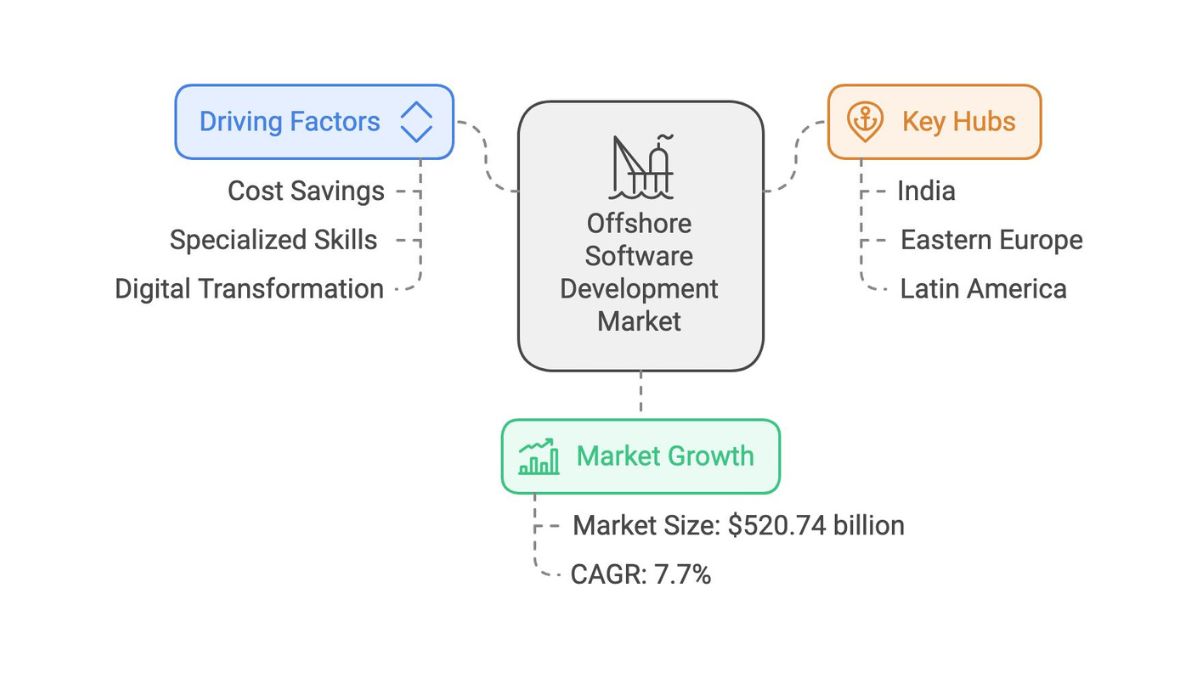
The offshore software development market has experienced explosive growth over the past two decades. According to a report by Grand View Research, the global IT services outsourcing market size was valued at $520.74 billion in 2019 and is expected to grow at a compound annual growth rate (CAGR) of 7.7% from 2020 to 2027. This growth is fueled by factors such as cost savings, access to specialized skills, and the need for digital transformation across industries.
Key Offshore Development Hubs
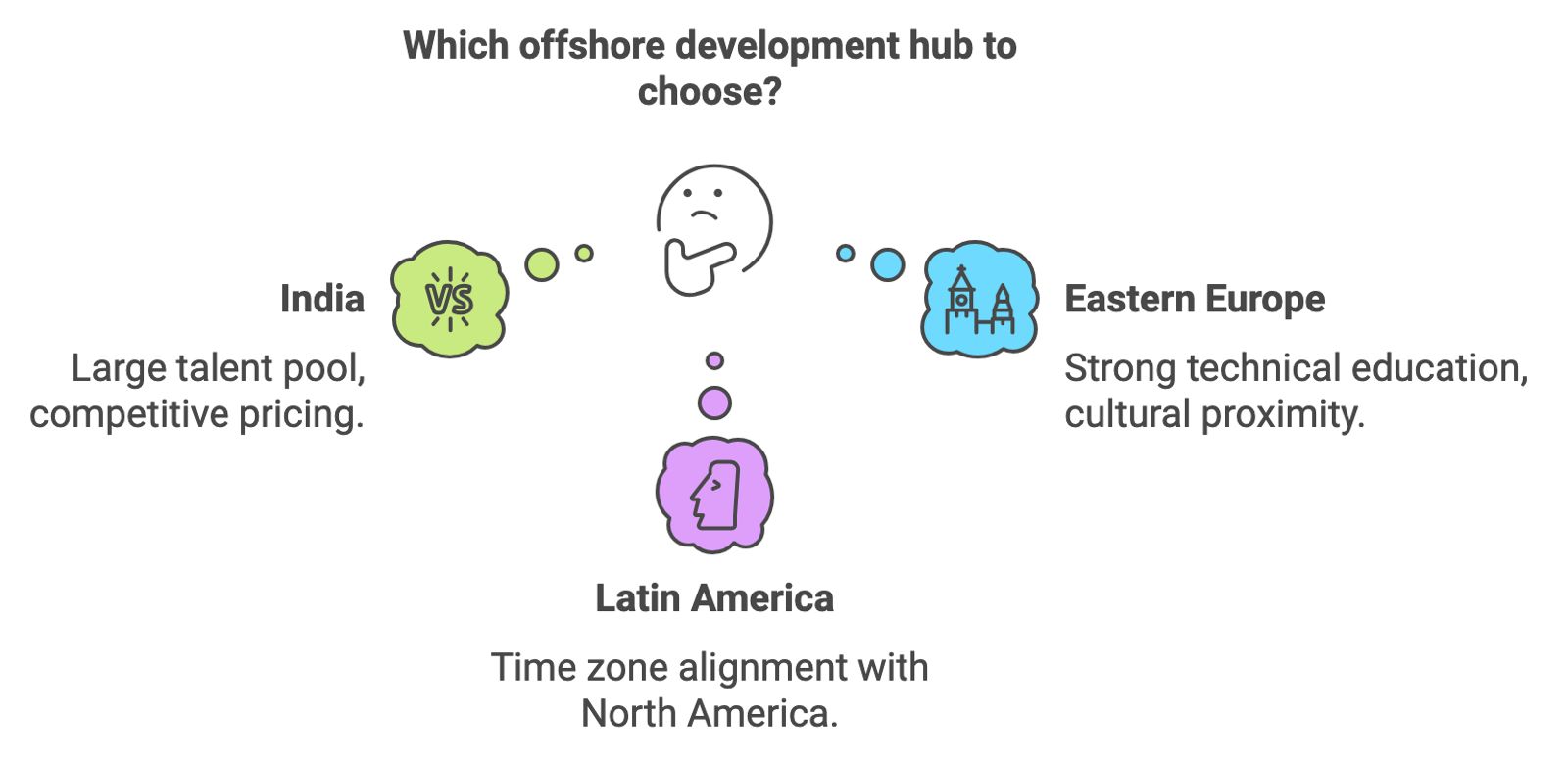
While offshore development services are available from numerous countries, several regions have emerged as prominent hubs:
- India: Known for its large pool of English-speaking tech talent and competitive pricing.
- Eastern Europe: Countries like Ukraine, Poland, and Romania are recognized for their strong technical education and cultural proximity to Western markets.
- Latin America: Nations such as Brazil, Argentina, and Mexico offer the advantage of time zone alignment with North American clients.
Each of these hubs has its unique strengths and considerations, which we'll explore further in this article.
Related Blog Post: How to Build a High-Performing Offshore Software Development Team
In-House Development: Breaking Down the Costs
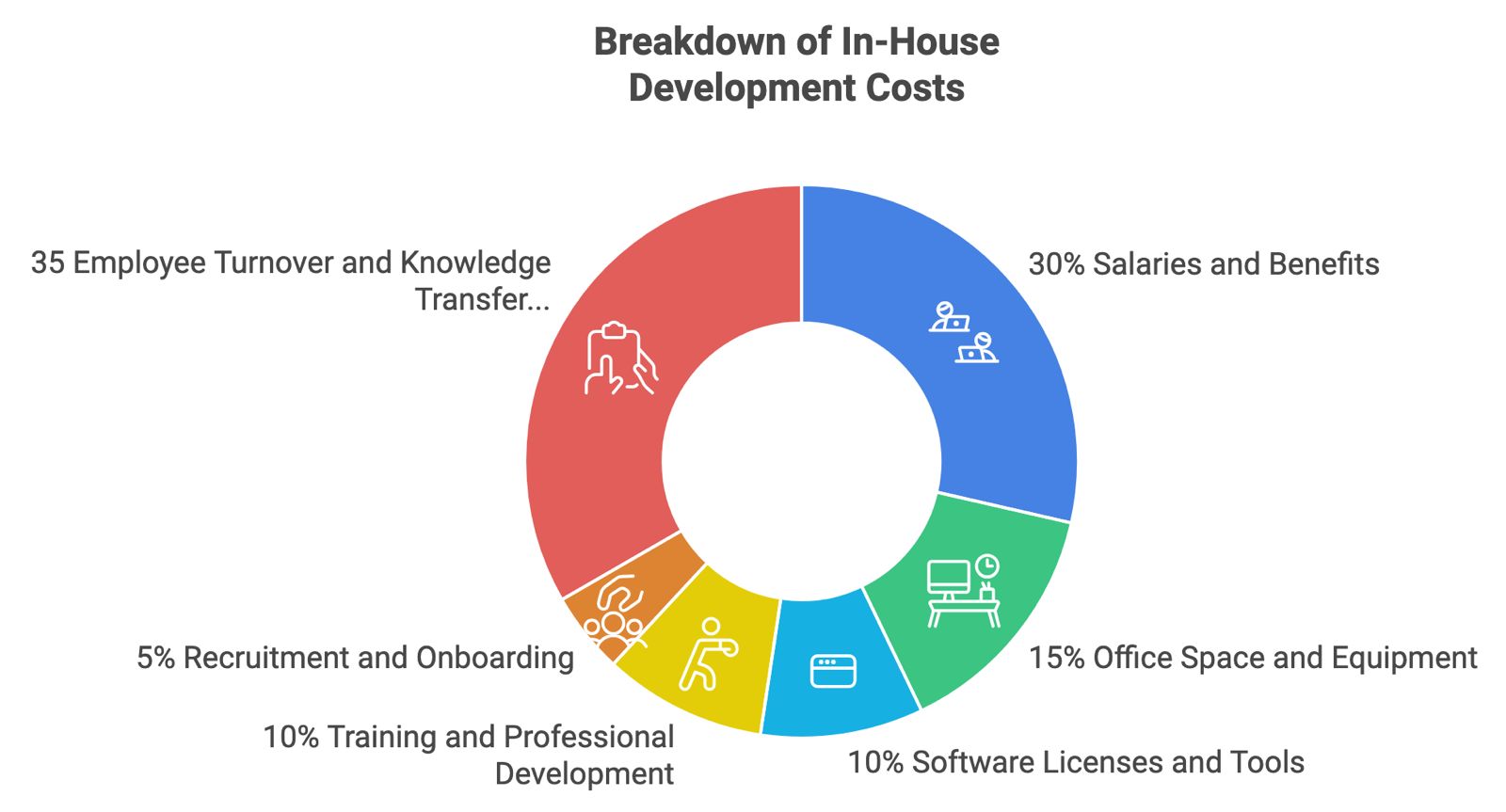
To truly understand the financial implications of in-house development, we need to look beyond just salaries. Let's break down the costs into three categories: direct costs, indirect costs, and hidden costs.
Direct Costs
- Salaries and Benefits: This is often the most significant expense for in-house teams. In the United States, the average salary for a software developer ranges from $65,000 to $150,000 per year, depending on experience and location. Add to this the cost of benefits such as health insurance, retirement plans, and paid time off, which can add 20-30% to the base salary.
- Office Space and Equipment: Physical workspace, desks, chairs, and computers are necessary for in-house teams. In tech hubs like San Francisco or New York, office space can cost $70-$100 per square foot annually. For a team of 10 developers, this could easily amount to $100,000-$150,000 per year.
- Software Licenses and Tools: Development tools, project management software, and other necessary applications come with their own costs. Depending on the tech stack and team size, this can range from $500 to $2,000 per developer annually.
- Training and Professional Development: Keeping your team's skills up-to-date is crucial in the fast-paced tech world. Budget for conferences, workshops, and online courses, which can cost $2,000-$5,000 per developer each year.
Indirect Costs
- Recruitment and Onboarding: Finding and hiring top talent is time-consuming and expensive. The Society for Human Resource Management (SHRM) estimates the average cost-per-hire at $4,129, with the process taking an average of 42 days.
- Employee Turnover and Knowledge Transfer: The tech industry is known for its high turnover rates. When a developer leaves, you not only incur recruitment costs but also face productivity losses during the transition period. This can cost up to 150% of the employee's annual salary.
- Management Overhead: In-house teams require management, which means additional salaries for project managers, team leads, and HR personnel. This can add 15-20% to your overall development costs.
- Scalability Challenges: Rapidly scaling an in-house team to meet project demands can be difficult and expensive, often leading to missed opportunities or delayed projects.
Hidden Costs
- Opportunity Cost of Slower Time-to-Market: In-house teams may take longer to ramp up new projects, potentially delaying product launches and missing market opportunities. This cost is hard to quantify but can be substantial in fast-moving industries.
- Technical Debt Accumulation: Without diverse project experience, in-house teams may accumulate technical debt over time, leading to increased maintenance costs and reduced agility in the long run.
- Potential for Skill Gaps and Limited Expertise: In-house teams may lack expertise in emerging technologies or specialized areas, potentially limiting innovation or requiring expensive external consultations.
Offshore Development: Understanding the Financial Implications

Offshore development presents a different cost structure, with its own set of direct, indirect, and hidden factors to consider.
Direct Costs
- Hourly Rates or Project-Based Pricing: Offshore development rates can vary widely based on location and expertise. Rates might range from $20-$50 per hour in some regions to $50-$150 in others, still often representing significant savings compared to in-house teams in high-cost areas.
- Communication Tools and Infrastructure: Investing in robust communication and project management tools is crucial for effective offshore collaboration. Budget $50-$200 per month per team member for these tools.
- Travel Expenses: Occasional face-to-face meetings can greatly enhance collaboration. Budget for 1-2 trips per year, which could cost $5,000-$10,000 per trip depending on team size and location.
Indirect Costs
- Time Zone Differences and Coordination Efforts: Managing teams across time zones requires additional coordination and can sometimes lead to delays. This may result in a 5-10% productivity loss if not managed effectively.
- Cultural and Language Barriers: Miscommunications due to cultural or language differences can lead to errors and rework. Invest in cultural training and language support to mitigate these issues.
- Quality Assurance and Oversight: Ensuring consistent quality may require additional QA resources or management oversight, adding 10-15% to your offshore development costs.
Hidden Benefits
- Access to a Global Talent Pool: Offshore development opens up a vast pool of specialized talent that might be scarce or expensive in your local market.
- Increased Flexibility and Scalability: Offshore teams can often scale up or down more quickly than in-house teams, allowing for greater agility in project management.
- 24/7 Development Cycles: With teams in different time zones, you can potentially achieve round-the-clock development, accelerating project timelines.
Comparative Analysis: In-House vs. Offshore Development

To provide a clear picture of how in-house and offshore development
compare, let's look at a side-by-side analysis of various factors:
Cost Comparison Table
| Cost Factor | In-House | Offshore |
| Salaries | $120,000/year | $40,000/year |
| Infrastructure | $15,000/year | $2,000/year |
| Scalability | $50,000 for 25% growth | $10,000 for 25% growth |
| Time-to-Market | 6 months | 4 months |
| Quality Assurance | $80,000/year | $60,000/year |
Productivity and Efficiency
While in-house teams often benefit from face-to-face collaboration, offshore teams can leverage time zone differences for continuous development cycles. A study by Deloitte found that 59% of companies using offshore development reported increased efficiency in their operations.
Quality and Technical Expertise
The quality of work from offshore teams can be on par with or even exceed that of in-house teams, especially when partnering with established offshore development firms. Many offshore hubs boast a high concentration of developers with advanced degrees and specialized skills that may be scarce in your local market.
Long-term Strategic Implications
- Innovation Potential: Offshore teams can bring diverse perspectives and experiences, potentially driving innovation in your products and processes.
- Competitive Advantage: By leveraging offshore development, companies can allocate more resources to core business functions and strategic initiatives, potentially gaining a competitive edge in their market.
Mitigating Risks in Offshore Development
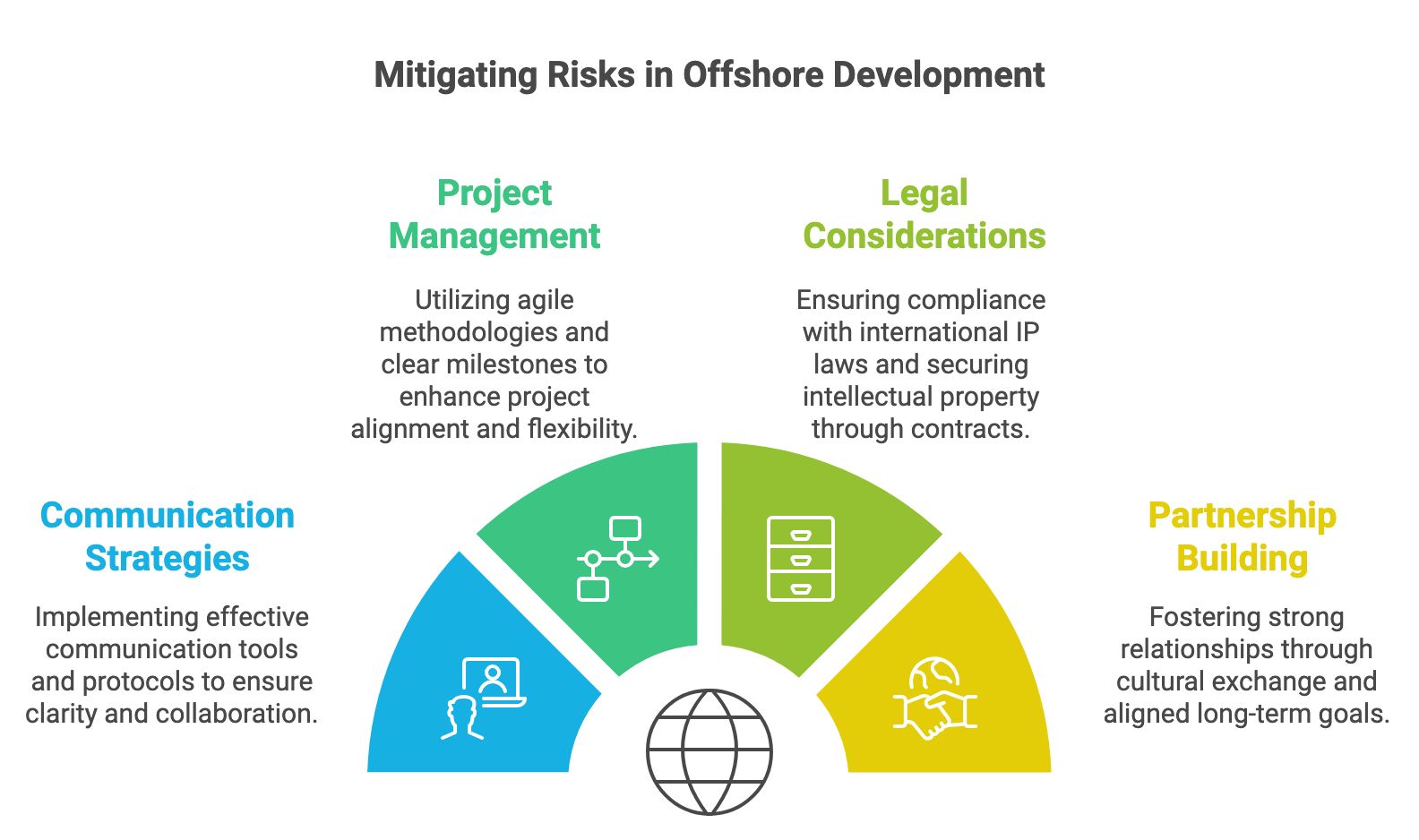
While offshore development offers numerous benefits, it's crucial to address potential risks:
Effective Communication Strategies
Implement daily stand-ups and regular video conferences
Use collaborative tools like Slack, Trello, and Jira
Establish clear communication protocols and expectations
Project Management Best Practices
Adopt agile methodologies for better alignment and flexibility
Set clear milestones and deliverables
Implement robust reporting and tracking systems
Legal and Intellectual Property Considerations
Ensure comprehensive NDAs and contracts are in place
Understand and comply with international IP laws
Implement secure development practices and access controls
Building a Strong Offshore Partnership
Invest time in cultural exchange and team building
Align on long-term goals and expectations
Regularly review and optimize the partnership
The Hybrid Approach: Balancing In-House and Offshore Teams

Many successful companies are adopting a hybrid model, combining the strengths of both in-house and offshore teams. This approach allows for:
- Core competencies and strategic projects to be handled in-house
- Specialized skills and scalable resources to be accessed offshore
- Improved 24/7 development cycles and faster time-to-market
To implement a successful hybrid model:
- Clearly define roles and responsibilities for each team
- Establish strong communication channels between in-house and offshore teams
- Create a unified company culture that spans geographical boundaries
- Implement consistent processes and quality standards across all teams
Choosing the Right Offshore Development Partner
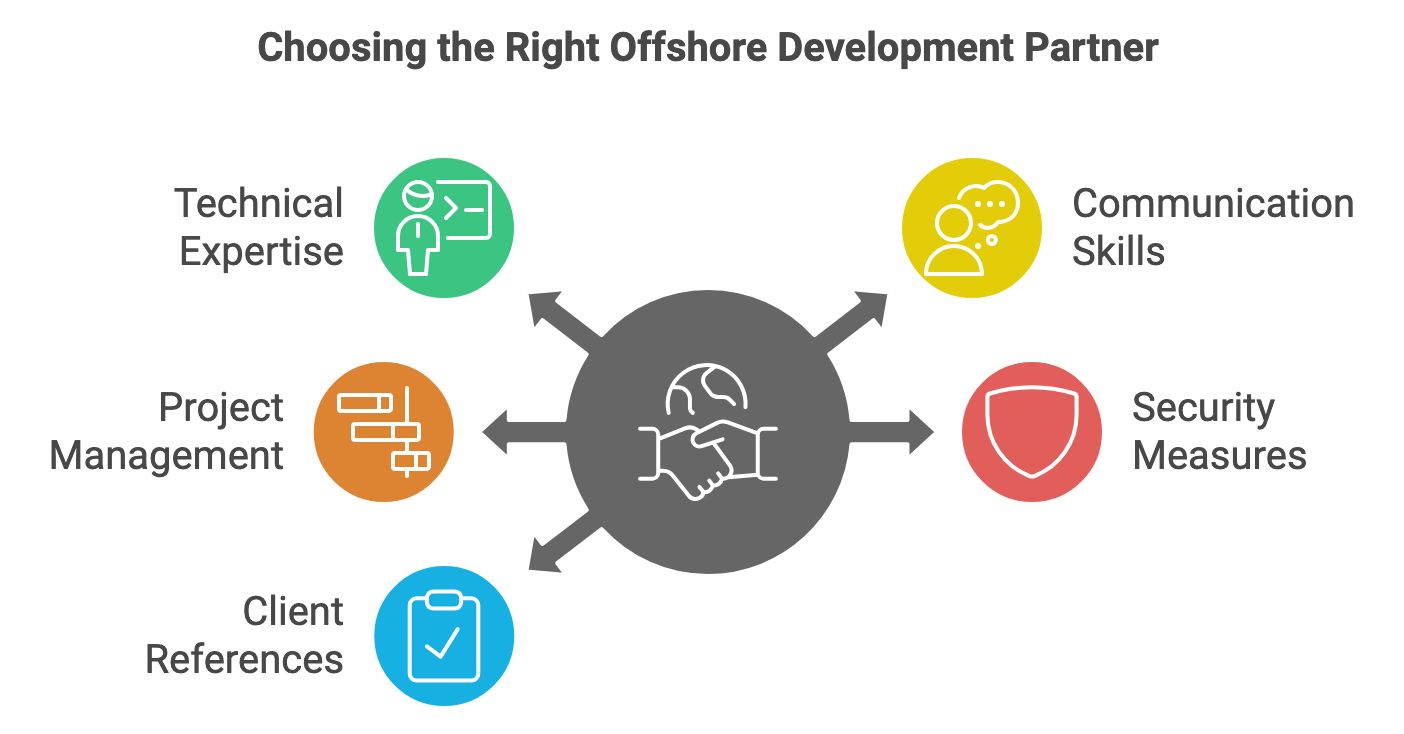
Selecting the right offshore partner is crucial for success. Consider the following factors:
- Technical expertise and industry experience
- Communication skills and cultural compatibility
- Project management methodologies and quality assurance processes
- Security measures and compliance with industry standards
- Client references and case studies
Conduct thorough due diligence, including:
- Video interviews with potential team members
- Code reviews of sample projects
- Trial projects to assess compatibility and quality of work
Related Blog Post: Top Benefits of Outsourcing Software Development: Cost Savings and Beyond
The Aqusag Advantage: 12+ Years of Offshore Excellence
At Aqusag Technologies, we bring over a decade of experience in delivering high-quality offshore development services to businesses across various industries. Our unique value proposition includes:
- Industry-Specific Expertise: With successful projects for clients like Coca-Cola, ServiceNow, and M Financial, we understand the nuances of different sectors and can tailor our approach to your specific needs.
- Cutting-Edge Technology Stack: Our teams are proficient in the latest technologies and frameworks, ensuring your projects leverage the most efficient and effective tools available.
- Rigorous Quality Assurance: We implement robust testing and quality control processes to deliver reliable, high-performance solutions.
- Seamless Communication: Our project managers and developers are fluent in English and trained in effective cross-cultural communication.
- Flexible Engagement Models: Whether you need a dedicated team, project-based work, or a hybrid model, we can adapt to your requirements.
- Strong Focus on Security and IP Protection: We adhere to strict security protocols and international standards to protect your intellectual property.
Don't just take our word for it, here's what some of our clients have to say.
Unlocking the power of global talent -The True Cost of In-House vs. Offshore Development Teams
Conclusion: Making the Right Choice for Your Business
Deciding between in-house and offshore development – or a hybrid of both – is a significant decision that can shape your company's future. By understanding the true costs, benefits, and potential risks of each approach, you can make an informed choice that aligns with your business goals and budget.
Remember, the most successful offshore partnerships are built on mutual trust, clear communication, and a shared commitment to excellence. Whether you're a startup looking to maximize your limited resources or an enterprise seeking to optimize your development processes, the right offshore strategy can provide substantial benefits.
As you consider your options, we invite you to explore how Aqusag Technologies can support your software development needs. With our proven track record, industry expertise, and commitment to client success, we're ready to help you navigate the complexities of offshore development and unlock your company's full potential.
Ready to take the next step? Schedule a discovery call or consultation with our team of experts. We'll discuss your specific needs, answer any questions you may have, and explore how we can create a tailored offshore development solution that drives your business forward.